A modern and distinctive armored car
Although by all accounts only one or two were ever built, the Romfell is a one of a kind military vehicle. With its distinctive inward-sloping body, circular turret, disc wheels, solid tires, and radio, it was the most modern and appealing of the armored cars at the time it was built. The mystery concerning their handmade production can be glanced at in the few photos taken. Two of these show the Romfell with different radiator grills and wheels. In the absence of reliable records, this could mean either a wartime modification or that two different vehicles were built.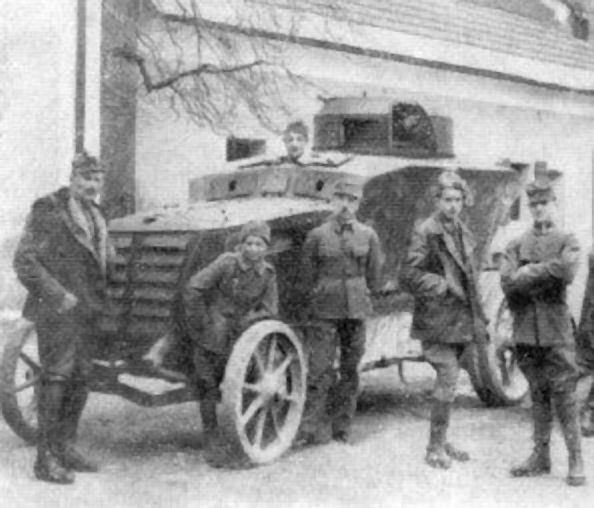
The second type of Romfell armored car, possibly built on a Fiat chassis. Source
Development of the Romfell
In 1905, the very promising Daimler armored car was dismissed by the Austro-Hungarian general staff as "not fit for service". It is said that the vehicle had scared the horse of at least one dignitary in an official demonstration.Emperor Franz Ferdinand himself declared these vehicles unfit for military operations. However, after 1914 the Austro-Hungarian Army soon realized its error. The trigger came from the Russians, who largely developed armored cars, and the Italians, who quickly followed in World War I. What is frequently forgotten is that the Eastern Front was largely mobile, contrary to the Western Front.
Previously, the sole operational Austro-Hungarian wartime armored car was the Junovicz P.A.1, which was very crudely made. By contrast, the Romfell almost looked like it was from another galaxy. It was built on a commercial car chassis and served well for the duration of the conflict. Like the Junovicz, the Romfell was dictated by immediate needs.
It was a private initiative starting low in the hierarchy, proposed by officers that simply took the matter into their own hands: Engineer Hauptmann Romanic and Oberleutenant Fellner. Their names were combined to christen the vehicle. According to Peter Jung, who unearthed most data about these forgotten vehicles, two models were built. The futuristic design was submitted and approved by the military. A prototype was authorized, to be delivered in the early summer of 1915 and tested in September to November.
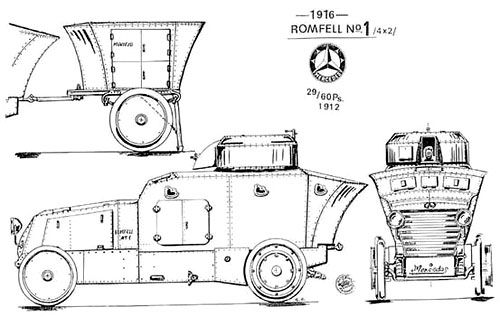
Blueprint of the 1915 Romfell
The first model allegedly used a Mercedes Motorcar (Personenkraftwagen) chassis, with the registration "A VI 865", propelled by a 95 hp motor with chain-transmission. It was low, almost sportscar-like, which gave the first vehicle an even more appealing look and an efficient low silhouette. The supposed second 1917/1918 model used a M09 Samson Seilwindenwagen or a Fiat chassis with a 4-cylinder 75 hp engine. The first vehicle was built at the Army's Automobil Ersatzdepot, being ready for trials in August.
Design
By far the most immediately recognizable trait of the Romfell armored car was its inwardly curved body, with no right angles or flat surfaces. This inwards-shape had the advantage of burying the ricochet rounds into the ground instead of bouncing them into the air.Thus, it was safer for accompanying infantry or cavalry, at least in theory. There are many reasons why this design was not used on other machines, one of them being it was too labor-intensive. Most armored cars in those days had outward angling flat, slab-sided armor. Automotive components had to be mounted on or near the chassis, and the smaller area in the lower part of the chassis of the Romfell would be problematic, while the larger area of the upper part could seem like a waste.
The armored body was riveted, 6 mm (0.24 in) thick, with a pronounced reverse rear slope. The driver's compartment had three armored shutters (one for the driver, one for the co-driver, and a central one for a second optional machine gun), two-piece side hatches, and a additional small double hatch over the driver's compartment.
The fully revolving, cylindrical turret was mounted in the center of the rear of the vehicle. It had a sloped roof and single sliding hatch for observation while buttoned-up. The only machine gun was an air-cooled Schwarzlose M07/12 protected by a gun shield, with a supply of 3,000 rounds. According to photos, the gun was able to elevate to nearly vertical, for AA fire. For mobility, the vehicle had four-wheel drive, dependent spring suspension, and solid rubber tires.
Range is estimated to be about 100 to 150 km (62 to 93 mi) and top speed 26 km/h (16 mph) on road. Equipment, remarkably, also included a Morse telegraph from Siemens & Halske. The blueprint also shows a towing hook for a small trailer, also featuring the inwards sloping armor.
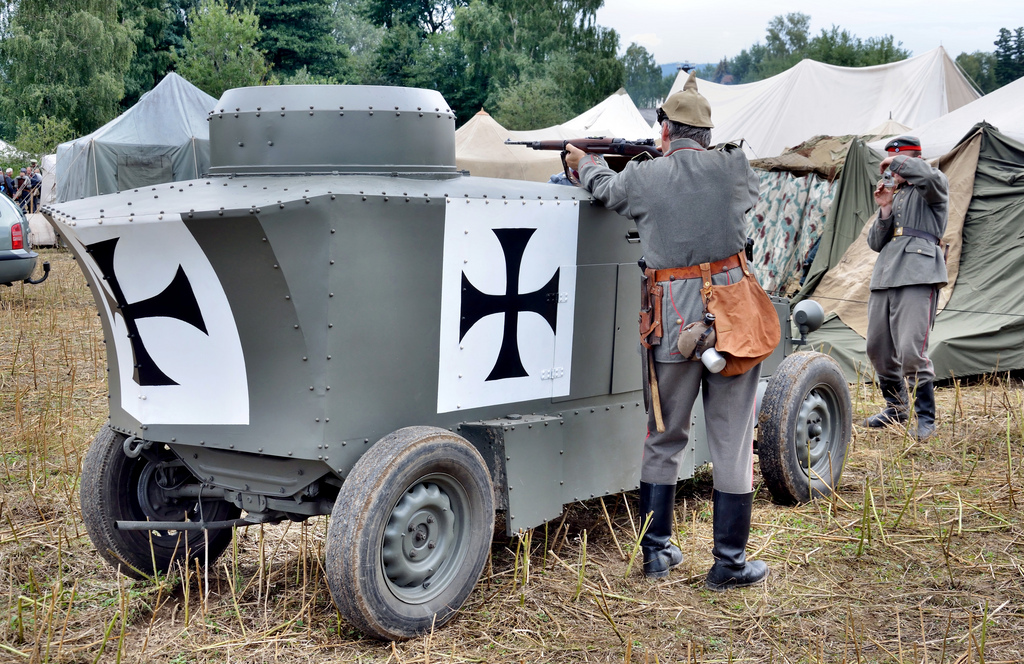
Modern reconstruction by Czech reenactors. Source
Fate
Operational history for the model is rather foggy. The 1915 vehicle could have been used in both the Balkans and in Russia. There is a photo of one Romfell on the Italian front in 1918, as part of K.u.K. Panzerautozug No.1. This unit was equipped with two Junovicz P.A.1s, one Romfell P.A.2, one captured Lancia Ansaldo IZ, and one ex-Russian Austin Armored Car. It operated in the vicinity of Udine, on the central Italian Front. The second model, according to Jung, was possibly damaged and rebuilt using a captured 2-ton Fiat chassis. This led to the supposition that even more Romfells were built on these Fiat chassis just before the end of the war.The Romfell may have been impressive and groundbreaking on paper, but it was nevertheless a disappointment in practice. It was slow, too heavy for its chassis, and had poor if any off-road capabilities. According to Peter Jung, one Romfell also fell into the hands of Romanian troops at the end of 1919, under the name «Resita». The final fate of the vehicles is unknown.
Links/sources
The Romfell on Landships.infoRudolf Hauptner & Peter Jung: "Stahl und Eisen im Feuer - Panzerzüge und Panzerautos des K.u.K. Heeres 1914-1918." Wien 2003. Peter Jung: "The Austro-Hungarian Forces in World War I (2) - 1916-18". Osprey Men-at-Arms 397.
Romfell armored car specifications |
|
| Dimensions | 5.67 x 1.8 x 2.4 m (18'7'' x 5'11'' x 7'10'') |
| Total weight, battle ready | 3 metric tons |
| Crew | 3 (driver, commander, machine-gunner) |
| Propulsion | Mercedes 95 hp, with chain-transmission |
| Speed | 26 km/h (16 mph) |
| Armament | 1 × 7.92 mm (0.31 in) Schwarzlose M.07/12 machine-gun with 3,000 rounds |
| Maximum armor | 6 mm (0.24 in) |
| Production | 2 |
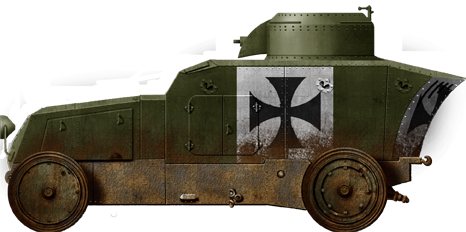
The first model Romfell as it appears in photos. There are few differences, except the radiator grille and the wheels, to separate it from the supposed second model.
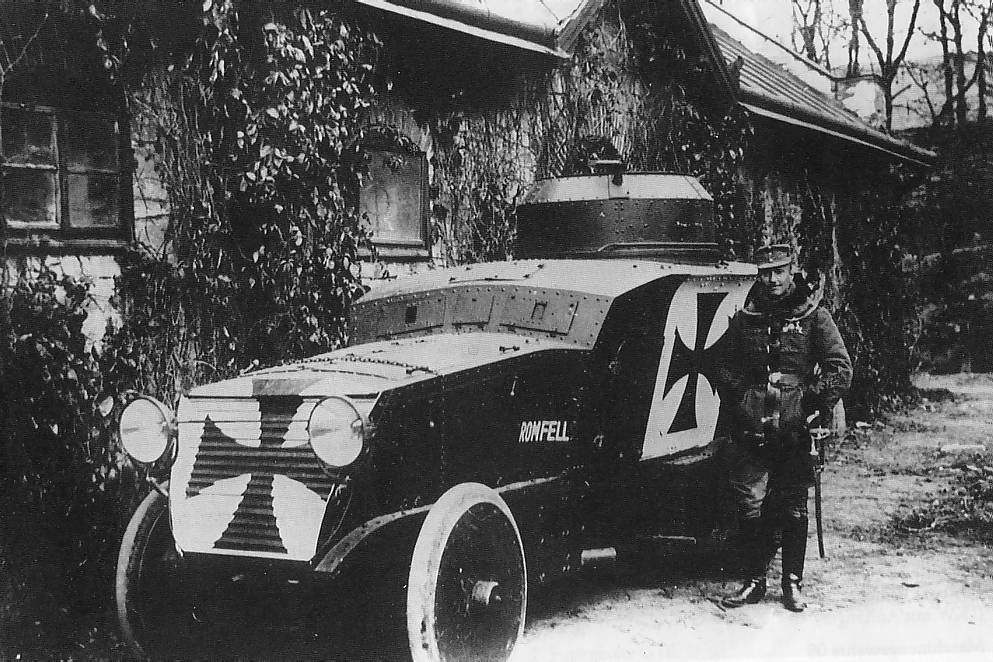
Source
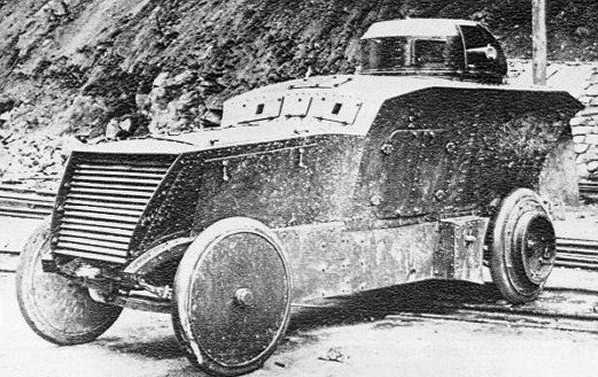
Source

Source

Source
Centennial WW1 POSTER


The Great War
 Austria-Hungary
Austria-Hungary Belgium
Belgium British Empire
British Empire France
France German Empire
German Empire Italy
Italy Russia
Russia USA
USAWW1 tanks posters
